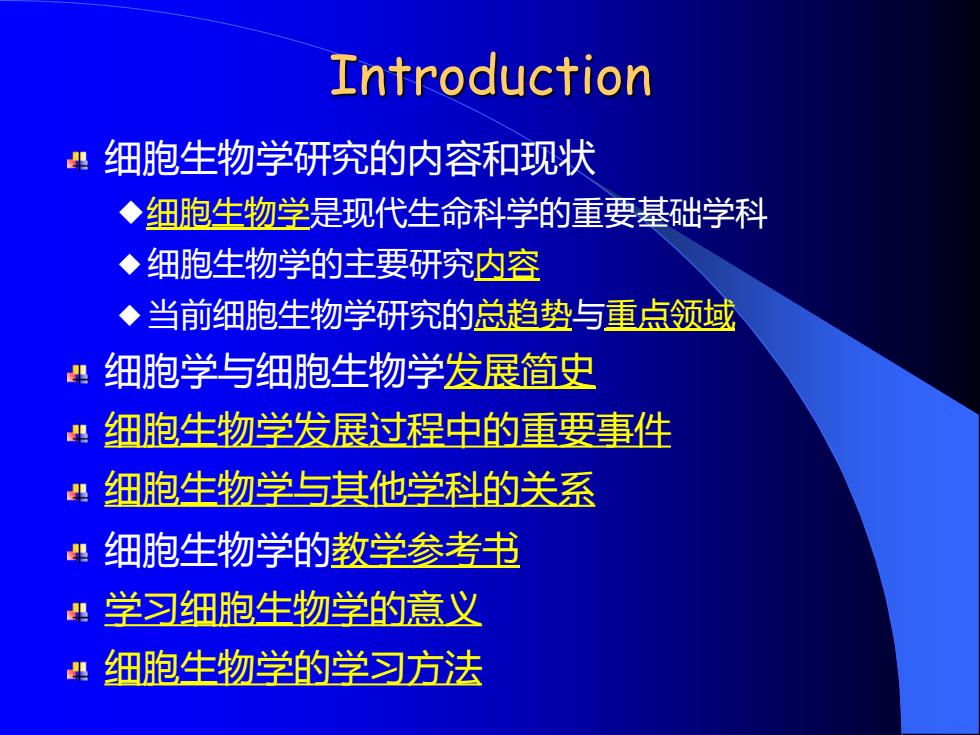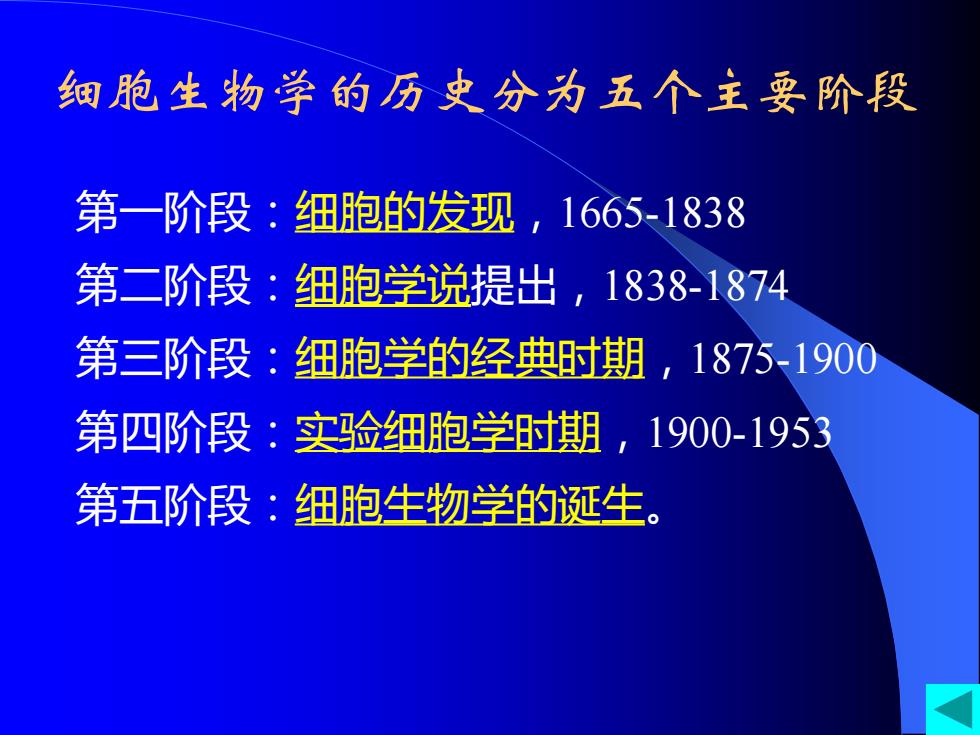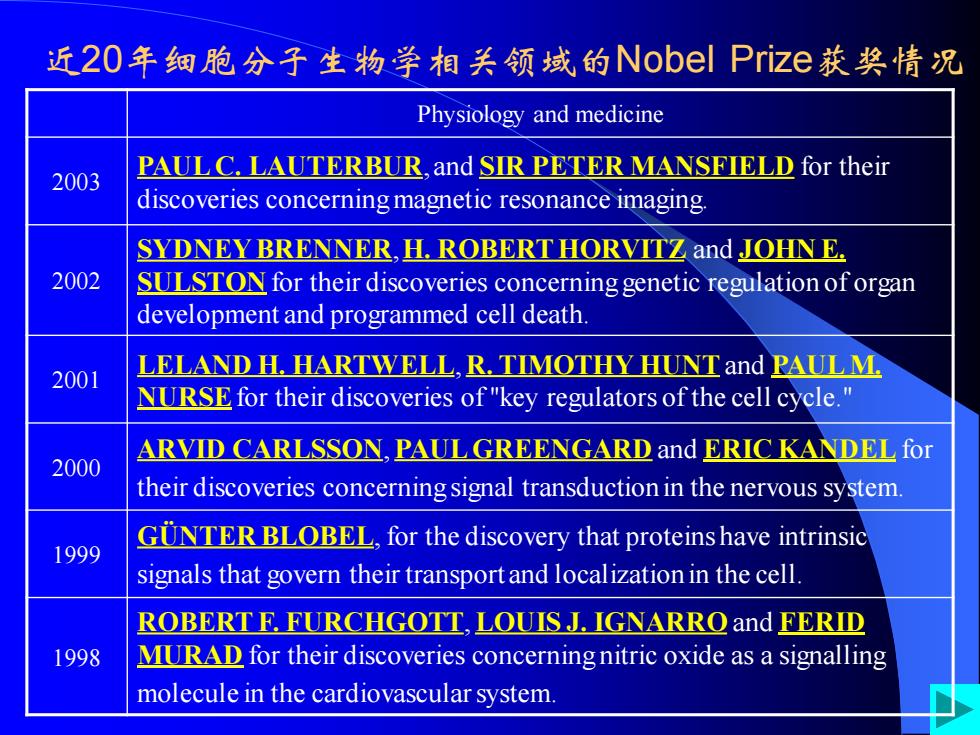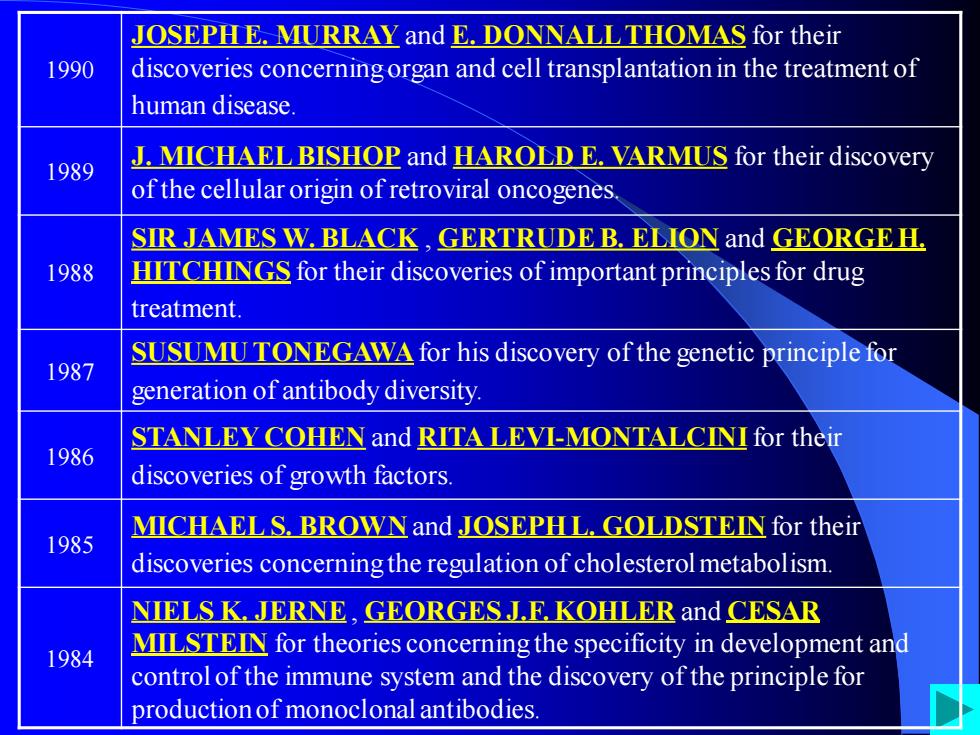
细胞生物学研究的内容和现状 细胞生物学是现代生命科学的重要基础学科 细胞生物学的主要研究内容 当前细胞生物学研究的总趋势与重点领域 细胞学与细胞生物学发展简史 细胞生物学发展过程中的重要事件 细胞生物学与其他学科的关系 细胞生物学的教学参考书 学习细胞生物学的意义 细胞生物学的学习方法 Introduction
细胞生物学研究的内容和现状 细胞生物学是现代生命科学的重要基础学科 细胞生物学的主要研究内容 当前细胞生物学研究的总趋势与重点领域 细胞学与细胞生物学发展简史 细胞生物学发展过程中的重要事件 细胞生物学与其他学科的关系 细胞生物学的教学参考书 学习细胞生物学的意义 细胞生物学的学习方法 Introduction

培养兴趣 明确框架,补充内容 每章结束后整理本章小结 充分利用各种资源(图书、网络) 重视实验,理论与实践相结合
培养兴趣 明确框架,补充内容 每章结束后整理本章小结 充分利用各种资源(图书、网络) 重视实验,理论与实践相结合

认识生命, 认识自我; 珍惜生命,爱护生命; 认识社会, 服务社会。 有人认为人的生存意义在于两个方面,即时间 和空间。生命是一种特殊形式的物质运动,它 是物质、能量和信息诸变量在特定时空的“表 演”,其运转有赖于生命系统有组织的守时和 对空间环境的合拍
认识生命, 认识自我; 珍惜生命,爱护生命; 认识社会, 服务社会。 有人认为人的生存意义在于两个方面,即时间 和空间。生命是一种特殊形式的物质运动,它 是物质、能量和信息诸变量在特定时空的“表 演”,其运转有赖于生命系统有组织的守时和 对空间环境的合拍

第一阶段:细胞的发现,1665-1838 第二阶段:细胞学说提出,1838-1874 第三阶段:细胞学的经典时期,1875-1900 第四阶段:实验细胞学时期,1900-1953 第五阶段:细胞生物学的诞生。 细胞生物学的历史分为五个主要阶段
第一阶段:细胞的发现,1665-1838 第二阶段:细胞学说提出,1838-1874 第三阶段:细胞学的经典时期,1875-1900 第四阶段:实验细胞学时期,1900-1953 第五阶段:细胞生物学的诞生。 细胞生物学的历史分为五个主要阶段

Cytology 1892年德国人O. Hertwig出版了《细胞与组 织》一书,使细胞学成为生物科学的一个独立分支 Molecular Biology 1953年Watson和Crick提出DNA双螺旋结模型 标志分子生物学的诞生; Cell Biology 1965年,D.P.Derobetis将其《普通细胞学》 改为《细胞生物学》,标志着细胞生物学的诞生; Molecular Cell Biology 80年代开始出现了分子细胞生物学
Cytology 1892年德国人O. Hertwig出版了《细胞与组 织》一书,使细胞学成为生物科学的一个独立分支 Molecular Biology 1953年Watson和Crick提出DNA双螺旋结模型 标志分子生物学的诞生; Cell Biology 1965年,D.P.Derobetis将其《普通细胞学》 改为《细胞生物学》,标志着细胞生物学的诞生; Molecular Cell Biology 80年代开始出现了分子细胞生物学

实验细胞学是指采用实验的手段研究细胞学的问题, 即从形态结构的观察深入到生理功能、生物化学及 遗传发育机理的研究。由于实验研究不断同相邻学 科结合、渗透,导致了一些重要分支学科的建立和 发展。 ◆cytogenetics的研究 ◆cytophysiology的研究 1912年, Carrel研制成Carrel培养瓶,采用严格的组 织培养技术,成功地培养了鸡胚胎成纤维细胞持续了 34年之久(1912-1946); ◆cytochemistry的研究
实验细胞学是指采用实验的手段研究细胞学的问题, 即从形态结构的观察深入到生理功能、生物化学及 遗传发育机理的研究。由于实验研究不断同相邻学 科结合、渗透,导致了一些重要分支学科的建立和 发展。 ◆cytogenetics的研究 ◆cytophysiology的研究 1912年, Carrel研制成Carrel培养瓶,采用严格的组 织培养技术,成功地培养了鸡胚胎成纤维细胞持续了 34年之久(1912-1946); ◆cytochemistry的研究

近20年细胞分子生物学相关领域的Nobel Prize获奖情况 Physiology and medicine 2003 PAUL C. LAUTERBUR, and SIR PETER MANSFIELD for their discoveries concerning magnetic resonance imaging. 2002 SYDNEY BRENNER, H. ROBERT HORVITZ and JOHN E. SULSTON for their discoveries concerning genetic regulation of organ development and programmed cell death. 2001 LELAND H. HARTWELL, R. TIMOTHY HUNTand PAUL M. NURSEfor their discoveries of "key regulators of the cell cycle." 2000 ARVID CARLSSON, PAUL GREENGARD and ERIC KANDEL for their discoveries concerning signal transduction in the nervous system. 1999 GÜNTER BLOBEL, for the discovery that proteins have intrinsic signals that govern their transport and localization in the cell. 1998 ROBERT F. FURCHGOTT, LOUIS J. IGNARRO and FERID MURAD for their discoveries concerning nitric oxide as a signalling molecule in the cardiovascular system
近20年细胞分子生物学相关领域的Nobel Prize获奖情况 Physiology and medicine 2003 PAUL C. LAUTERBUR, and SIR PETER MANSFIELD for their discoveries concerning magnetic resonance imaging. 2002 SYDNEY BRENNER, H. ROBERT HORVITZ and JOHN E. SULSTON for their discoveries concerning genetic regulation of organ development and programmed cell death. 2001 LELAND H. HARTWELL, R. TIMOTHY HUNTand PAUL M. NURSEfor their discoveries of "key regulators of the cell cycle." 2000 ARVID CARLSSON, PAUL GREENGARD and ERIC KANDEL for their discoveries concerning signal transduction in the nervous system. 1999 GÜNTER BLOBEL, for the discovery that proteins have intrinsic signals that govern their transport and localization in the cell. 1998 ROBERT F. FURCHGOTT, LOUIS J. IGNARRO and FERID MURAD for their discoveries concerning nitric oxide as a signalling molecule in the cardiovascular system

1997 STANLEY B. PRUSINER for his discovery of Prions - a new biological principle of infection 1996 PETER C. DOHERTY and ROLF M. ZINKERNAGEL for their discoveries concerning the specificity of the cell mediated immune defence. 1995 EDWARD B. LEWIS, CHRISTIANE N躍SLEIN-VOLHARD and ERIC F. WIESCHAUS for their discoveries concerning the genetic control of early embryonic development. 1994 ALFRED G. GILMAN and MARTIN RODBELL for their discovery of G-proteins and the role of these proteins in signal transduction in cells. 1993 RICHARD J. ROBERTS and PHILLIP A. SHARP for their independent discoveries of split genes. 1992 EDMOND H. FISCHER and EDWIN G. KREBS for their discoveries concerning reversible protein phosphorylation as a biological regulatory mechanism. 1991 ERWIN NEHER and BERT SAKMANN for their discoveries concerning the function of single ion channels in cells
1997 STANLEY B. PRUSINER for his discovery of Prions - a new biological principle of infection 1996 PETER C. DOHERTY and ROLF M. ZINKERNAGEL for their discoveries concerning the specificity of the cell mediated immune defence. 1995 EDWARD B. LEWIS, CHRISTIANE N躍SLEIN-VOLHARD and ERIC F. WIESCHAUS for their discoveries concerning the genetic control of early embryonic development. 1994 ALFRED G. GILMAN and MARTIN RODBELL for their discovery of G-proteins and the role of these proteins in signal transduction in cells. 1993 RICHARD J. ROBERTS and PHILLIP A. SHARP for their independent discoveries of split genes. 1992 EDMOND H. FISCHER and EDWIN G. KREBS for their discoveries concerning reversible protein phosphorylation as a biological regulatory mechanism. 1991 ERWIN NEHER and BERT SAKMANN for their discoveries concerning the function of single ion channels in cells

1990 JOSEPH E. MURRAY and E. DONNALL THOMAS for their discoveries concerning organ and cell transplantation in the treatment of human disease. 1989 J. MICHAEL BISHOP and HAROLD E. VARMUS for their discovery of the cellular origin of retroviral oncogenes. 1988 SIR JAMES W. BLACK , GERTRUDE B. ELION and GEORGE H. HITCHINGS for their discoveries of important principles for drug treatment. 1987 SUSUMU TONEGAWAfor his discovery of the genetic principle for generation of antibody diversity. 1986 STANLEY COHEN and RITA LEVI-MONTALCINIfor their discoveries of growth factors. 1985 MICHAEL S. BROWN and JOSEPH L. GOLDSTEIN for their discoveries concerning the regulation of cholesterol metabolism. 1984 NIELS K. JERNE, GEORGES J.F. KOHLER and CESAR MILSTEIN for theories concerning the specificity in development and control of the immune system and the discovery of the principle for production of monoclonal antibodies
1990 JOSEPH E. MURRAY and E. DONNALL THOMAS for their discoveries concerning organ and cell transplantation in the treatment of human disease. 1989 J. MICHAEL BISHOP and HAROLD E. VARMUS for their discovery of the cellular origin of retroviral oncogenes. 1988 SIR JAMES W. BLACK , GERTRUDE B. ELION and GEORGE H. HITCHINGS for their discoveries of important principles for drug treatment. 1987 SUSUMU TONEGAWAfor his discovery of the genetic principle for generation of antibody diversity. 1986 STANLEY COHEN and RITA LEVI-MONTALCINIfor their discoveries of growth factors. 1985 MICHAEL S. BROWN and JOSEPH L. GOLDSTEIN for their discoveries concerning the regulation of cholesterol metabolism. 1984 NIELS K. JERNE, GEORGES J.F. KOHLER and CESAR MILSTEIN for theories concerning the specificity in development and control of the immune system and the discovery of the principle for production of monoclonal antibodies

Chemistry 2003 PETER AGRE, for the discovery of water channels and the other half of the prize to RODERICK MACKINNON for structural and mechanistic studies of ion channels. 2002 JOHN B. FENN, and KOICHI TANAKA, for their development of soft desorption ionisation methods for mass spectrometric analyses of biological macromolecules and the other half toKURT WÜTHRICHfor his development of nuclear magnetic resonance spectroscopy for determining the three-dimensional structure of biological macromolecules in solution. 1997 PAUL D. BOYER and JOHN E. WALKER for their elucidation of the enzymatic mechanism underlying the synthesis of adenosine triphosphate (ATP) and with one half toJENS C. SKOU for the first discovery of an ion-transporting enzyme, Na+, K+-ATPase
Chemistry 2003 PETER AGRE, for the discovery of water channels and the other half of the prize to RODERICK MACKINNON for structural and mechanistic studies of ion channels. 2002 JOHN B. FENN, and KOICHI TANAKA, for their development of soft desorption ionisation methods for mass spectrometric analyses of biological macromolecules and the other half toKURT WÜTHRICHfor his development of nuclear magnetic resonance spectroscopy for determining the three-dimensional structure of biological macromolecules in solution. 1997 PAUL D. BOYER and JOHN E. WALKER for their elucidation of the enzymatic mechanism underlying the synthesis of adenosine triphosphate (ATP) and with one half toJENS C. SKOU for the first discovery of an ion-transporting enzyme, Na+, K+-ATPase